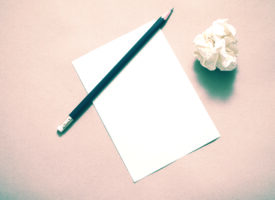He wrote the book on how to write killer query letters. In this interview, author John Wood shares his knowledge based on 17 years of working as an editor. More
than 30,000 query letters have landed on his desk. Wood lets us in on the things that make or break query letters, and how you, the writer, can get past the editor’s desk and be published.
A Query Letter That Stands Out
Because most queries look and read the same, your query letter must stand out.
“Devise a scintillating title and subtitle for your idea in the style of the magazine you’re pitching,” says Wood. “Center it and boldface it right up front after your initial introductory paragraph. Use bullets, numbered lists, indented paragraphs, italics or even boxes to set off important elements. Don’t go overboard, but do something to make your letter stand out from the pack.
“My former editor demanded that I do thiswhenever I proposed an idea to him because with a head and deck at the top of the page, he could envision instantly what it would look like in the magazine,” Wood explains. “I have used this technique ever since when approaching editors and agents, and have been told by more than one agent that my queries were the best they have ever seen.”
Your query letter should be no more than a page or a page and a half, and should contain a brief introduction as to why you’re writing that specific magazine. Mention your expertise or interest in your proposed topic, and include one or two ideas, presented in decks and heads. In your closing paragraph, briefly mention who you are, your publication credits and how you can be reached.
Include one or two clips of your writing, but only if your clips are similar to your proposed topic. There’s no point in sending a cooking article clip if you’re querying a travel article!
The 4 Most Common Mistakes to Avoid
“Of all the ones that I rejected, I found that the writers were making the same simple mistakes or omissions,” Wood reveals. “Unfortunately, reject letters never tell you what you did wrong, so most writers just continue to make the same mistakes.”
According to Wood, there are 4 common mistakes writers commit when writing and submitting query letters:
Mistake # 1. Sending your query to the wrong editor
“This is crucial,” says Wood. “Call the magazine, ask for ‘Editorial,’ and ask which editor handles the subject you’re submitting.
“If you’re sending a query for a health article, ask which editor handles health features. If you’re sending a pitch for the New Products department, ask which editor oversees the New Products department, and so on,” he advises. “If the receptionist gives you the editor-in-chief’s name or says, ‘Just send it in,’ do not accept this. Demand a specific name for your specific topic. If she can’t or won’t, ask to speak to her supervisor.”
When Wood was editor, writers who took their time to do their homework, learn that he was the right editor for their proposed story and then approach him directly by query letter always got top priority.
“Unfortunately, less than 5-10 percent of all submissions arrive to me–or any editor–that way. Writers who act in this manner earn my respect and I will assume they are professionals and treat them accordingly,” Wood says.
And those who don’t? Their queries don’t garner much interest and go straight to the slush pile.
Mistake # 2. Failing to narrow your story angle
“Don’t send a query about horseback riding,” Wood warns. “Send one about horseback riding for blind black women lesbians along the Malibu coast during Kwanzaa. I’m exaggerating, but I guarantee you that a query like the first example will go nowhere; one focused to the degree of the second example will find a market somewhere.”
Mistake # 3. Not studying the magazine thoroughly before querying
Take time to know what a magazine wants and doesn’t want. Know its readers and style the articles are written in. Do these things and you will be able to write a query letter that will catch any editor’s eye.
Mistake # 4. Forgetting to include a self-addressed stamped envelope or SASE with the query
5 Things You Should Never Do
- Don’t be presumptuous. Avoid even an appearance of cockiness or arrogance.
- Don’t be sketchy. Outline your idea in sufficient depth to give the editor a clear picture of
your idea and what you intend to do. - Don’t offer an article on spec.
- Never apologize or give a lame reason for wanting to write your article.
- Don’t even think about querying by phone.
If You’re an Amateur, Don’t Give Yourself Away!
If you’ve never been published before, Wood warns you shouldn’t mention it in your query letter.
“You must never give the appearance that you are a beginner or an amateur,” he says. “If you present yourself in a professional manner, the editor can only assume you’re a pro and will treat you like one.
“I have given many assignments over the years to writers who I thought were seasoned pros and then found out later that they were just starting out,” he continues. “That’s fine. But once you let the cat out of the bag and make a slip of the pen (‘This is my first query to a magazine’), it’s an automatic rejection. Few editors will knowingly work with beginners.
“If you have been published before, but only to small newsletters or church flyers or local newspapers, do not mention this or attach such clips,” he adds.
The Query-able Stuff
You don’t need to query every idea you think is publishable.
“The only articles that do not and should not require a query are humor, essays, poems, short fiction, and puzzles/games. These particular types of pieces are subjective and cannot be assigned; you simply have to write them and send them in,” Wood says.
The Waiting Game
So, is it acceptable to send multiple queries on the same subject? Wood says yes.
“Shotgun the sucker to as many editors as you can. You’re the writer; you’re the one who has to pay your bills while waiting (sometimes for months) to hear back from each publication,” Wood explains. “Editors are notorious for not replying at all–even if you include an SASE. The obvious exception would be an idea that is focused to a particular magazine; in that case you should only send it to that place. But that doesn’t mean you couldn’t rewrite it and refocus the same general idea to several different similar magazines and send them all out at the same time.
“One lesson I’ve learned: Do not mention that your query is a simultaneous submission,” John advises. He once thought it was necessary until one editor got offended and rejected his query. That editor, according to Wood, only wanted articles “specifically tailored to my magazine.”
“My idea was a unique travel idea that was certainly appropriate to his publication, but to many others as well,” Wood explains.
After shotgunning your idea to as many editors as possible, it’s time for you to wait it out.
“Wait about a month, then follow-up by e-mail,” he advises. “Never phone unless you’ve worked with the editor before. If still no response, assume it’s a reject and move on.”
10 Ways To Get Your Query Letter Accepted
- Be professional. Make sure every letter is error-free, is addressed to the right editor, and includes a SASE.
- Be new. Offer a fresh idea and set it off with a centered, boldfaced head and subhead.
- Be provocative. Pull the reader in with a stunning lead.
- Be creative. Lay out your letter in a unique way and show your writing style. Don’t write formally! Write the way you talk, write in your own voice. You have only one chance to impress the editor. If you go down, go down in flames, baby.
- Be focused. Narrow your story angle as much as you can.
- Be customized. Slant your idea to each individual publication as much as you can.
- Be multifaceted. Give each editor more than one reason to say yes: Offer more than one place for your article, more than one thing to peg it to, more than one way to structure it, and more than one element to accompany it.
- Be realistic. Instill confidence that you’re reliable and your project is doable.
- Be qualified. Include appropriate clips, credits, and qualifications.
- Be passionate. Show enthusiasm for your project.
© Shery Ma Belle Arrieta
Visit Shery’s website, The e-Writer’s Place, a comprehensive site for writers of all ages and levels, at http://ewritersplace.com.



